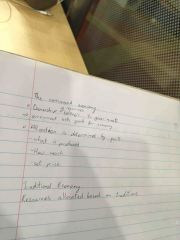![]()
![]()
![]()
Use LEFT and RIGHT arrow keys to navigate between flashcards;
Use UP and DOWN arrow keys to flip the card;
H to show hint;
A reads text to speech;
30 Cards in this Set
- Front
- Back
|
Economics |
The study of how society allocates scarce resources |
|
|
Advantages of division of labour |
1. Specialize in what their good at. 2. Learning by doing 3. Economies of scale |
|
|
Market |
An institution where buyers and sellers come together. |
|
|
Market Economy |
-private ownership -allocation of resources depends on prices established in markets |
|
|
Command economy and traditional economy |

Back (Definition) |
|
|
Different types of consumer models |
-more is better -diminishing Marginal Utility |
|
|
What is more is better? |
An assumption that a consumer generally prefers more of a good. |
|
|
What is more is better? |
An assumption that a consumer generally prefers more of a good. |
|
|
Diminishing marginal utility |
Gains to utility from the first unit are larger than the gains from the subsequent unit. |
|
|
Opportunity cost |
How much it cost or how much must be given to obtain a good. |
|
|
Production possibility frontier |
Combination of goods and services a country can produce with full employment of their resources. |
|
|
Production Efficiency |
Cannot produce another unit of one good without giving up units of another. |
|
|
Allocative efficiency |
Combination that maximizes social welfare |
|
|
Absolute advantage |
Ability of the producer to produce the same amount of goods using fewer resources. |
|
|
Economies of scale |
Average cost per unit falls as a firm produces more. |
|
|
Demand |
Maximum willingness to pay for the next available unit |
|
|
Market economy |
Resources allocated among households and firms, little or no government interference. |
|
|
Market Demand |
The horizontal summation of each individual's quantity demanded at every price. |
|
|
Demand shifters |
-income -related goods -compliments -taste and preferences -number of buyers -price expectations |
|
|
Demand increases |
Curve shifts right |
|
|
Demand decreases |
Curve shifts left |
|
|
Supply |
All those willing and able to produce /sell/supply the good/service make up supply. |
|
|
Quantity supplied |
The amount of a good or service that sellers are willing and able to supply at various prices. |
|
|
Law of supply |
Price and quantity supplied are positively related |
|
|
Market equilibrium |
QS=Q |
|
|
Buyers are unhappy when |
P is not equal to P equilibrium |
|
|
Supply shifters |
-technology -number of firms -price of input |
|
|
Supply increases |
Curve shifts down |
|
|
Supply decreases |
Supply curve shifts up |
|
|
Consumer surplus and producer surplus |

Bam |

